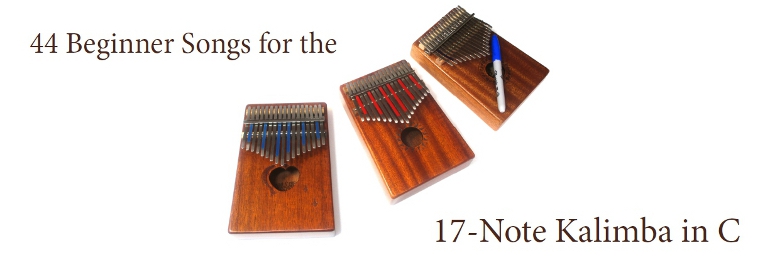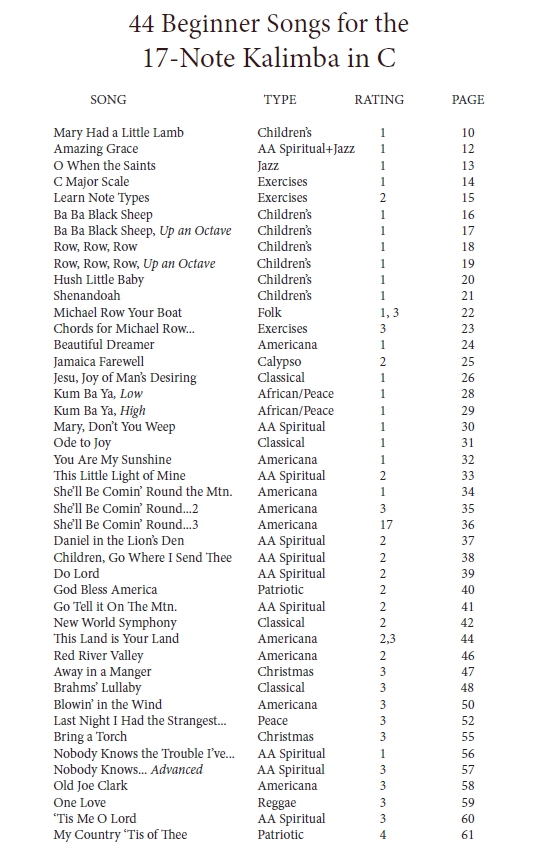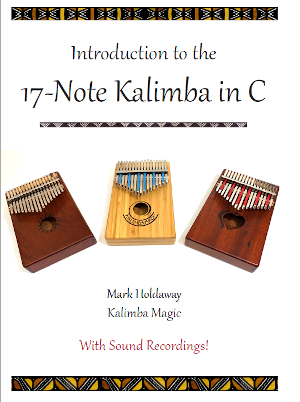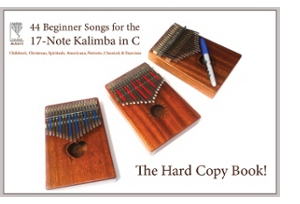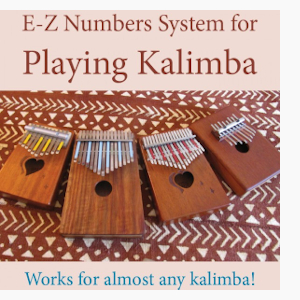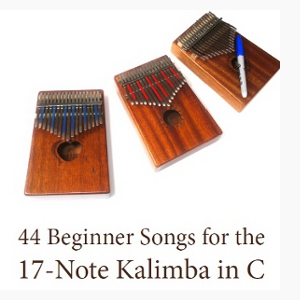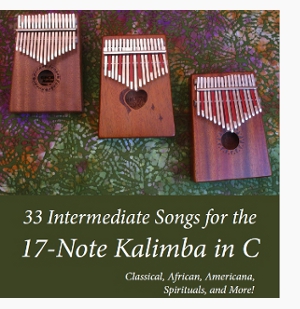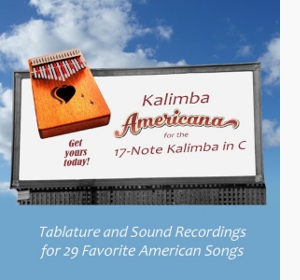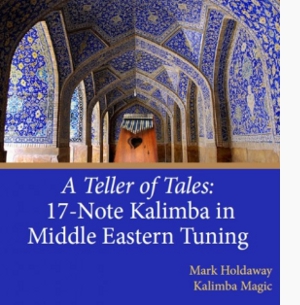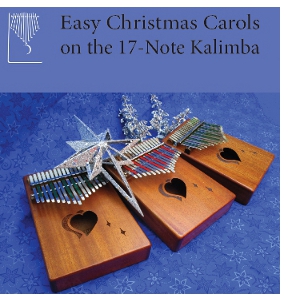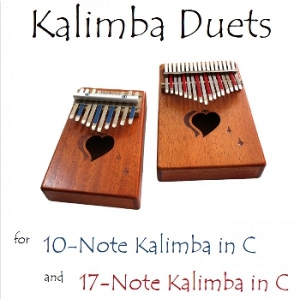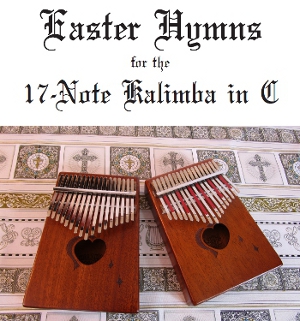- Калимба мелодии ноты 17 язычков
- 66 Songs for the 17-Note Kalimba in C
- The 66 Songs Download has been replaced with user friendly 44-Beginners-Songs and 33-Intermediate-Songs
- What if I only have five tines painted? What do I do?
- Book: 44 Beginner Songs for the 17-Note Kalimba in C
- E-Z Numbers System for Playing Any Kalimba
- 44 Beginner Songs for the 17-Note Kalimba in C
- 33 Intermediate Songs for the 17-Note Kalimba in C
- Kalimba Americana for the 17-Note Kalimba in C
- Middle Eastern Music for the 17-Note / C
- Easy Christmas Carols on the 17-Note Kalimba in C
- Kalimba Duets for 10-Note and 17-Note in C
- Easter Hymns for the 17-Note Kalimba in C
- Калимба мелодии ноты 17 язычков
- Калимба мелодии ноты 17 язычков
Калимба мелодии ноты 17 язычков
Табулатуры для требла в строе До Мажор (и производных от «до») вынесены в отдельную тему:
https://vk.com/topic-50568834_39524165
В этой теме все остальное.
На иностранных сайтах табулатуры для калимбы расположены так, что они читаются снизу вверх. Я подбирала мелодии к песням и, для того чтобы можно было согласовать табулатуру с текстом расположила ноты так, что они читаются сверху вниз.
Вот табулатуры для достаточно известной мелодии Greensleeves и примеры исполнения этой мелодии.
Ниже приведено видео для требл-калимбы, исполняет — Евгений Шаля.
Очень красивая композиция. Автор и исполнитель — Никита Афанасьев. Особенность ее состоит в том, что она состоит из двух частей — игра аккордами и мелодия, от чего создается ощущение, что играют сразу два инструмента. В табулатурах красным выделены те ноты, которые создают мелодию, те что обозначены черным, это аккорды. Для тех, кому тяжело играть эту мелодию, можно сначала проиграть по красным нотам. Услышав и почувствовав мелодию можно добавить в нее аккорды.
Эти табулатуры написаны по видео, поэтому цифры слева означают время на видео, когда играется та или иная часть мелодии.
Эта мелодия ирландской баллады Cruel Sister. Здесь представлены несколько вариантов исполнения этой мелодии. Я ее подбирала под голос Meldis, так что, во время игры можно даже себе подпевать. Табулатуры написаны для стандартного строя Требл-калимбы.
Cruel sister.
There lived a lady by the North Sea shore
(Lay the bent to the bonnie broom)
Two daughters were the babes she bore
(Fa la la la la la la la la la)
As one grew bright as is the sun,
So coal black grew the elder one.
A knight came riding to the lady’s door,
He’d travelled far to be their wooer.
He courted one with gloves and rings,
But he loved the other above all things.
Oh sister will you go with me
To watch the ships sail on the sea?
She took her sister by the hand
And led her down to the North Sea strand.
And as they stood on the windy shore
The dark girl threw her sister o’er.
Sometimes she sank, sometimes she swam,
Crying, «Sister, reach to me your hand!»
«Oh Sister, Sister, let me live,
And all that’s mine I’ll surely give.»
«(It’s) your own true love that I’ll have and more,
But thou shalt never come ashore.»
And there she floated like a swan,
The salt sea bore her body on.
Источник
66 Songs for the 17-Note Kalimba in C
The 66 Songs Download has been replaced with user friendly 44-Beginners-Songs and 33-Intermediate-Songs
The 44 songs in the download were taken from various Kalimba Magic collections and modified for use with the 17-Note “Treble” Kalimba in the key of C, which is sold under a great many brand names at this time – Donner, Walter, Heart-17, and Gecko, among others. The collections that went into this download include: African American Spirituals, traditional African karimba tunes, classical pieces, folk and pop music, Americana and patriotic, and some children’s songs.
These songs are rated by difficulty, with songs in each category between 1 and 5.
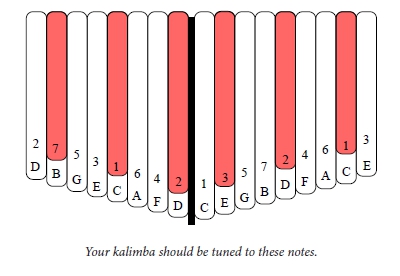
My customers had a hard time trying to download the old “66 Song” Zip file to their cell phones and such, so we are replacing the old product with “44 Beginners Songs for the 17-Note Kalimba in C” – a single PDF file that can be downloaded to cell phones, tablets, iBooks, and your desktop computer (available Jan 8 2019). Coming soon is “33 Intermediate Songs” and “22 Insanely Difficult Songs”.
We have added ten more Level 1 songs to the original collection and simplified many of the arrangements, focusing on Level 1, 2, and 3 songs. Now, this download really is oriented toward the beginning kalimba player. Look for “33 Intermediate Songs for the 17-Note” in 5-10 days.
What if I only have five tines painted? What do I do?
If your kalimba has 5 painted tines, including the center tine, and its low note is a B, and it has F# notes, then you have the Hugh Tracey Treble kalimba in standard G tuning. Which means that there is a different 66 Songs download for the Treble Kalimba that will work for your instrument..
If you are in the key of C with a lowest note of C, but you have 5 painted notes, then you are in between. You could retune to the standard G tuning with low note of B (a standard G major Treble Kalimba), or you could remove the paint or decals and repaint as a C Treble with six painted tines as above.
By the way, the song that plays in the media viewer below, “Deck the Halls,” is a Level 4 arrangement that is no longer in this collection. It is, however, in the “Easy Christmas Carols for the 17-Note Kalimba in C” download.
This hard copy book serves as a great overarching introduction to playing the 17-Note kalimba. It includes discussion about your kalimba’s tuning, how your tines should be painted, your kalimba’s parts, thumb nail care, fixing buzzes, special playing techniques, kalimba tablature, several helpful playing strategies, chords and arpeggios, a few songs, how to add harmonies and accompaniment to simple melodies, alternative tunings, the history of the kalimba, additional kalimba resources, and blank tablature. Sound files are accessible by a special URL or a QR code. 32 pages.
Book: 44 Beginner Songs for the 17-Note Kalimba in C
Finally! A hard copy 62-page book with downloadable MP3 files for each song! This is the exact same material as the 44 Songs download. This is a great way to learn to play the 17-Note Kalimba in C. Contains children’s songs, “Shenandoah,” “Beautiful Dreamer,” “Ode to Joy,” “You Are My Sunshine,” “God Bless America,” “Nobody Knows the Trouble I’ve Seen,” “My Country ‘Tis of Thee,” and much more.
E-Z Numbers System for Playing Any Kalimba
This numbers-based ebook (download) works with essentially any kalimba. It shows you which tines you need to mark with numbers – use a Sharpie pen. For 6-notes, 8-notes, 10-notes, 15-notes, and 17-note kalimbas… and probably for every other kalimba in between. If you feel that kalimba tablature is beyond you, try starting here.
44 Beginner Songs for the 17-Note Kalimba in C
This is a 62-page, PDF ebook with live links to MP3 files for each song. This is a great way to learn to play the 17-Note Kalimba in C. Contains children’s songs, “Shenandoah,” “Beautiful Dreamer,” “Ode to Joy,” “You Are My Sunshine,” “God Bless America,” “Nobody Knows the Trouble I’ve Seen,” “My Country ‘Tis of Thee,” and more.
33 Intermediate Songs for the 17-Note Kalimba in C
An 82-page, PDF ebook with live links. This is a great next step for learning the 17-Note Kalimba in C after you have worked through most of the “44 Beginner Songs” or “Easy Christmas Carols” ebooks. Songs include “Bach’s Minuet,” “Finlandia,” “Jesu, Joy of Man’s Desiring,” “Shumba Panzira,” “Chemtengure,” “Suwannee River,” “Wayfarin’ Stranger,” “We Shall Overcome,” “Hard Times Come Again No More,” “Marine’s Hymn,” “De Colores,” “Swing Low Sweet Chariot,” “O Danny Boy,” and more.
Kalimba Americana for the 17-Note Kalimba in C
A 54-page, PDF ebook with live links. This is a great collection of music in the traditions of American folk, spirituals, and patriotic music. Songs rated between Level 0 and Level 4. Of the 29 songs, 18 are Level 0, 1, or 2, making this a good option for beginning kalimba players.
Middle Eastern Music for the 17-Note / C
This Middle Eastern tuning makes amazingly beautiful, powerful, exotic music. It is really a journey I can recommend to most anyone. The music you can play in this kalimba tuning takes you around the world in its musical expressions. I find this music to be so beautiful that I recommend you purchase the download just to listen to the recordings that come with, even if you don’t play kalimba.
Easy Christmas Carols on the 17-Note Kalimba in C
This 82-page PDF ebook is a delightful way to learn to play the 17-Note Kalimba in C. It starts out with simple melodies and progresses by adding more harmony notes as you make your way through the book. 28 songs (there are multiple versions of some songs). You likely have known most of these songs since you were a child: “Silent Night,” “The First Noel,” “O Christmas Tree,” “Jingle Bells,” “O Come All Ye Faithful,” “Deck the Halls,” “Away in a Manger,” “Carol of the Bells,” and more.
Kalimba Duets for 10-Note and 17-Note in C
This ebook is a PDF file with live links to the sound files that will illustrate how each song is supposed to sound, for the 10-Note, the 17-Note, and for the two kalimbas together. Seventy pages, including 22 duets for the 10-Note kalimba in C and the 17-Note kalimba in C.
This book of duets gives you several great ideas for how two kalimbas can fit together to make music, from unison and simple thirds harmony to continuo, counterpoint, hocket, kushaura and kitsinhira parts… and rounds. Great fun, with an emphasis on how to create beautiful music with mostly simple parts working together.
Easter Hymns for the 17-Note Kalimba in C
An 39-page, PDF ebook with live links to the MP3 files. Each of 12 songs are presented in both a basic version and an advanced version. The basic versions tend to be melody-only, or with a little bit of harmony. The advanced versions have full harmony, counterpoint, multiple melody lines, etc – enough to keep you busy for many Easters to come. Includes: “All Creatures of our God and King,” “Lord of the Dance,” “Holy, Holy, Holy,” “Joyful, Joyful, We Adore Thee,” and “This is My Father’s World.”
Источник
Калимба мелодии ноты 17 язычков
Калимба До мажор перестроена. Строй от самого длинного язычка к самому короткому по-порядку: C#, F#, Ab, A, Bb, B, C. C#, D, Eb, E, F, F#, Ab. A, B, C#
Точки сверху означают октаву. Строй охватывает первую октаву, вторую и три ноты третьей.
Табулатуры для мелодии Lilium.
Здесь представлены две версии табулатуры для удобства, одна с раскраской язычков такой как рекомендует производитель, другой как у Альто-калимбы. Красными точками отмечена партия аккомпанемента, а черными сама мелодия. Черные линии, соединяющие ноты мелодии так же нарисованы просто для удобства ориентирования.
Для игры этой мелодии на калимбе До-мажор, надо перестроить все язычки F на F#.
Источник
Калимба мелодии ноты 17 язычков
Введение. Пост №1.
Что означают буквы на язычках калимбы на рисунках? Каким нотам соответствуют язычки? Что такое строй инструмента? У Вас появились подобные вопросы?
Эта тема создана для тех, кто делает первые шаги в мир музыки в качестве начинающего музыканта. Не всем в жизни довелось получить музыкальное образование.
Ответы на эти и подобные вопросы могут помочь Вам самостоятельно учиться играть на калимбе, понять как настраивать и перестраивать её.
Названия нот знают все. На рисунке вы можете увидеть те самые буквенные обозначения, которые видите на схемах для настройки калимбы. Также показано каким нотам эти буквы соответствуют. На рисунке одна октава.
Отличить одинаковые по названию, но разные по высоте ноты помогают октавы.
На латинском языке октава (octava) означает восьмая, что можно трактовать как восьмой звук.
На рисунке выше изображена одна октава. Для наглядности мы демонстрируем всё на клавиатуре фортепиано. Что такое октава?
Привычная нам последовательность нот: ДО, РЕ, МИ, ФА, СОЛЬ, ЛЯ, СИ, ДО.
Октава — это расстояние между двумя клавишами с одинаковыми названиями. Например, расстояние от ноты РЕ до следующей ноты РЕ образует одну октаву. В каждой октаве 7 белых клавиш и 5 черных.
На рисунке ниже изображены две октавы фортепиано. От ноты ДО слева до ноты ДО в середине — одна октава. От Крайней ноты ДО слева до крайней ноты ДО справа — две октавы.
На этом рисунке показан 5-ти октавный синтезатор. Так же даны названия октав. Строй обычных калимб позволяет играть ноты малой октавы и первой октавы.
Для записи нот от ДО до СИ в Латинской системе используются буквы латинского алфавита C, D, E, F, G, A, H. Обратите внимание, что ноту СИ обозначает не буква B, а H. Буквой B обозначают СИ-БЕМОЛЬ (хотя в англоязычной литературе и некоторых сборниках гитарных аккордов всё чаще это правило нарушается).
Поэтому нет ничего страшного, если в обозначении нот вы встретите ноты написанные по-разному.
СИ — B (по правилам латинской нотации это не верно, но в обозначении нот калимбы обычно употребляется именно эта буква) или H (в табулатурах калимбы обычно не встречается).
СИ-БЕМОЛЬ — B (в обозначении нот калимбы обычно так обозначается только нота СИ) или Bb (стандартное обозначение для калимбы).
Сравните. На первой картинке изображены обозначения нот «по-правилам». На второй картинке так же нет ошибки, такое обозначение нот обычно используется при игре на калимбе.
Немного терминологии. Пост №8
Звукоряд — В основу музыкальной системы положен ряд звуков. Этих звуков ровно 88, расположены они в порядке возрастания высоты звука (свойство звука: высота): от самых низких до самых высоких. Расположение звуков по высоте назвали звукорядом.
Ступень звукоряда — Каждый звук какого-либо звукоряда называется ступенью этого звукоряда. Все знают названия 7-ми нот: до, ре, ми, фа, соль, ля, си. Это звукоряд ДО-МАЖОР, а эти ноты названия основных ступеней звукоряда (См. пост №16).
Альтерация – это изменение высоты основных ступеней звукоряда (основные ступени звукоряда, например, ДО-МАЖОР – это до ре ми фа соль ля си) (См. пост №9).
Знаки альтерации. Пост №9
Снова вернемся к клавиатуре фортепиано. До этого мы обращали внимание только на белые клавиши. Теперь посмотри на черные.
Каждая октава состоит не из 8 нот ( ДО, РЕ, МИ, ФА, СОЛЬ, ЛЯ, СИ, ДО), а из 12. Если смотреть на клавиатуру фортепиано и читать их по порядку то получится так: ДО, ДО-ДИЕЗ, РЕ, РЕ-ДИЕЗ, МИ, ФА, ФА-ДИЕЗ, СОЛЬ, СОЛЬ-ДИЕЗ, ЛЯ, ЛЯ-ДИЕЗ, СИ, ДО. Или в латинской системе: C, C#, D, D#, E, F, F#, G,#, A#, B.
В нотах и настройке калимбы часто встречаются «знаки альтерации», условно говоря диезы и бемоли.
Диез – это повышение звука на полтона, бемоль – понижение его на полтона. После того, как нота изменена, то к её основному названию просто прибавляется одно слово – соответственно, диез или бемоль. Например, до-диез, фа-диез, ля-бемоль, ми-бемоль и т.д. В нотах же диезы и бемоли обозначаются специальными знаками, которые тоже называются диезами и бемолями. Используется и ещё один знак – бекар, он отменяет всякую альтерацию, и тогда, вместо диеза или бемоля, мы играем основной звук. Посмотрите, как это выглядит в нотах:
Источник



